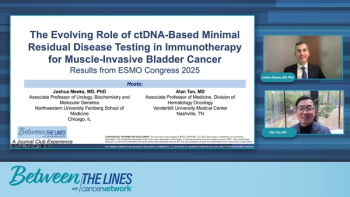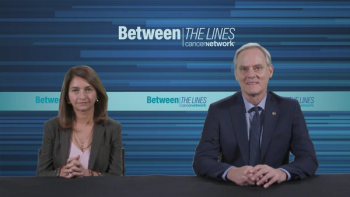
The Evolution of EGFR-Mutated Advanced NSCLC Treatment: Present Considerations and Future Treatment Options
Samuel Rosner, MD, discusses how the treatment landscape for EGFR-mutated non–small cell lung cancer has evolved from first-generation targeted therapies to osimertinib as the current standard of care, while exploring emerging options like fourth-generation tyrosine kinase inhibitors, antibody-drug conjugates, and bispecific therapies to overcome resistance mechanisms.
Episodes in this series

This segment discusses the evolution of treatment for EGFR-mutated non–small cell lung cancer, highlighting a decade-long revolution in targeted therapy. Initially, first- and second-generation agents targeting specific EGFR mutations (L858R and exon 19 deletions) showed rapid responses in the early 2010s, but resistance was almost inevitable. This led to research into resistance mechanisms, particularly the T790M alteration on exon 20, which eventually resulted in the development of osimertinib, a third-generation targeted therapy that could overcome this resistance.
Osimertinib has become the new standard of care due to its superior progression-free survival benefits, improved tolerability compared with earlier agents like erlotinib and afatinib, and excellent central nervous system penetration for treating brain metastases. The drug allows patients to maintain better quality of life, with visits every 3 months once stabilized, making it an attractive option. However, treatment decisions have become increasingly complex as new frontline therapy options emerge, requiring careful consideration of patient characteristics, disease location, symptom burden, molecular features, performance status, and quality of life preferences through shared decision-making.
Emerging treatment strategies focus on overcoming osimertinib resistance through fourth-generation tyrosine kinase inhibitors that maintain brain penetration, antibody drug conjugates with single or bispecific targets, and MET-directed therapies. There's renewed interest in immunotherapy combinations, particularly bispecific therapies targeting VEGF and PD-1, which may provide long-term benefits previously unavailable to EGFR-mutated patients. Additionally, cellular-based strategies like bispecific T-cell engagers, which have shown success in small cell lung cancer, represent promising future directions. The field continues to expand with increasing research opportunities and treatment options for patients.
Newsletter
Stay up to date on recent advances in the multidisciplinary approach to cancer.





















































































